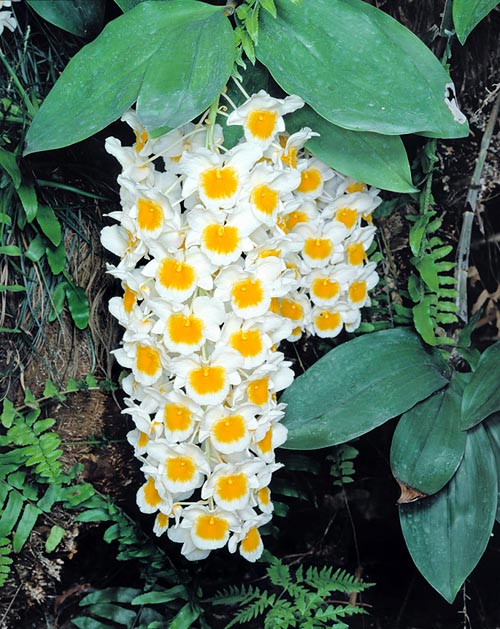Family : Orchidaceae

Text © Pietro Puccio

English translation by Mario Beltramini

The showy inflorescences of the Dendrobium farmeri reach the 30 cm © Giuseppe Mazza
The name of the genus is the combination of the Greek terms “déndron” = tree and “bios” = life, with reference to the numerous species of the genus living on the trees; the species is honoured to the English collector W.F. Farmer, in whose greenhouse it did bloom for the first time in Europe.
The Dendrobium farmeri Paxton (1849) is an epiphytic species with fusiform pseudobulbs with four ribs, 20-30 cm long, carrying in the terminal part 2-4 persistent leaves, coriaceous, ovate-lanceolate with pointed apex, 6-15 cm long and 3-5 cm broad.
The inflorescences, from an upper node, also of the old leafless pseudobulbs, are drooping, up to about 30 cm long, carrying 12 to 35 flowers of 4-5 cm of diameter, of white or pale mauve pink colour with yellow-orange spot on the labellum; the flowers, slightly perfumed, last about two weeks.
The sepals are oblong, 2 cm long and 1 cm broad, the petals are ovate, 2,5 cm long and 2 cm broad, slightly fringed at the edges, the labellum is almost circular, about 2 cm long and broad, slightly pubescent. It reproduces by seed, in vitro, by micropropagation and by division, with each section provided of 4-5 pseudobulbs.
It is a much ornamental species and of rather easy cultivation, it requires a slight shade, high humidity, 60-80%, and medium-high temperatures during the vegetative period.
It does not require a specific period of rest in winter, but cooler temperatures, with minimum of 12-14 °C, and spaced waterings, allowing the compost to dry up well before irrigating again, the excess of humidity during this period may cause rooting rottenness, but without leaving the pseudobulbs to wrinkle too much, gradually increasing the humidity when the inflorescences do appear; a good ventilation is essential in all seasons.
For the waterings and the nebulisations are to be used rainwater, water obtained by revered osmosis or demineralised one; the fertilizations, duly distributed and alternated, in way to avoid salts accumulations on the roots, are to be done during the vegetative period preferably with hydro-soluble balanced products, with microelements, at half dosage, or less, than what suggested on the package.
It may be mounted on bark, cork or arborescent ferns raft or cultivated in pots or baskets with very draining and aerated compost, that can be formed by medium-sliced bark fragments. It does not love to be disturbed, therefore repottings and divisions are to be done when strictly indispensable and at the moment when the new roots do appear.
The species is inscribed into the appendix II of the CITES (species whose trade is internationally ruled).
Synonyms: Callista farmeri (Paxton) Kuntze (1891); Callista farmeri (Paxton) Brieger (1981).
→ For general notions about ORCHIDACEAE please click here.
